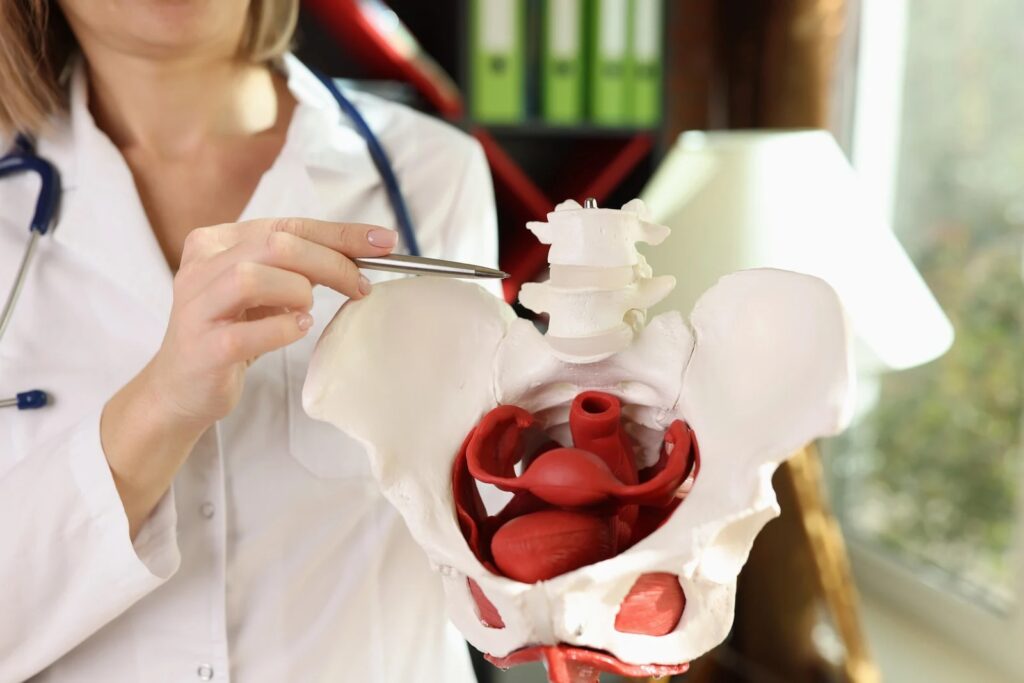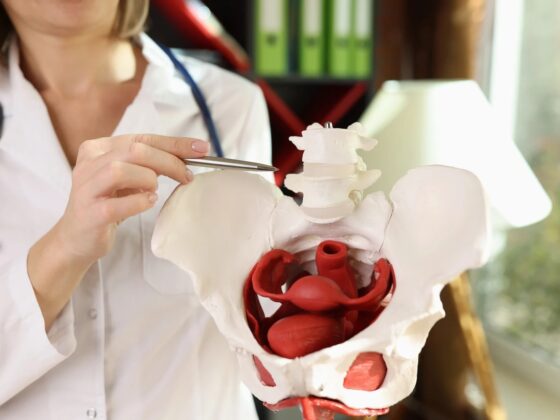
What is EDS?
Ehlers-Danlos Syndrome (EDS) is a group of genetic connective tissue disorders that can cause pain in joints and muscles, excessive motion in joints, fragile but stretchy skin. Hypermobility Spectrum Disorder (HSD) differs from EDS, where patients do not meet the full criteria for EDS but have many similar symptoms of joint hypermobility and pain. Despite not qualifying for the stricter diagnosis, HSD is still a valid and clinically recognized diagnosis that benefits from appropriate management.
What is the Pelvic Floor?
The pelvic floor is a foundational group of muscles, fascia, ligaments and connective tissue that attaches to the bones of the pelvis. These tissues form a supportive internal sling that holds up internal organs like the bladder, uterus, and rectum. In addition to organ support, the pelvic floor plays essential roles in core stability, respiration, sexual function and waste elimination.
Pelvic Floor Dysfunction in EDS and HSD
In individuals with Hypermobility Spectrum Disorder (HSD) or Ehlers-Danlos Syndrome (EDS), along with the connective tissue in the rest of the body, the tissue within and surrounding the pelvic floor sling is affected which can lead to pelvic floor dysfunction. However, pelvic floor dysfunction in EDS isn’t always about being “too loose.” In fact, more often than not, it’s actually the opposite.
People with EDS/HSD often don’t have the same stability or proprioceptive feedback that other bodies provide due to their altered connective tissue. Because of this, people with HSD or EDS can compensate unconsciously by over-recruiting or gripping their pelvic floor muscles. While this creates stability for the trunk and increases proprioceptive awareness in daily life, if left unchecked it can create chronic tension and shortening of the muscles. Ultimately, these shortened muscles can lead to imbalances and eventually pelvic floor dysfunction.
EDS and pelvic floor dysfunction common complaints:
- Urinary urgency or leakage
- Sensation of a UTI without a positive test
- Chronic constipation and/or diarrhea cycles
- Chronic pelvic pain
- Pain with sex or reduced interest in intimacy
- Pelvic pressure or heaviness
Pelvic Organ Prolapse (POP) in EDS and HSD
Pelvic Organ Prolapse occurs when the pelvic floor tissues weaken and one or more of the pelvic organs begin to protrude and press against the vaginal walls. Patients often report symptoms like a feeling of pressure, discomfort, or a bulge in the vaginal region that can be more pronounced during or after physical activity.
Prolapse is an issue that can often occur in individuals with EDS and pelvic floor dysfunction, especially during post-partum. During pregnancy, increased laxity occurs to assist in carrying and delivery of the baby, and in a hypermobile body, it can take 6 to 9 months for the ligaments to return to their previous state, or as long as the mother continues to breastfeed.
But prolapse isn’t limited to just postpartum, all too often the chronic tension and gripping of the muscles lead to the eventual inability to keep internal organs properly supported. Individuals who have never been pregnant can still develop prolapse from lifelong issues with constipation and straining, chronic stress or trauma, or from poor intra-abdominal pressure during activities like weightlifting. Chronic pelvic floor tension, as opposed to laxity, can be the root cause of pelvic floor dysfunction weakening support over time.

EDS & Physical Therapy
Frequently treated pelvic floor dysfunctions in the HSD/EDS population:
- Pain with sex: Often due to chronic gripping or muscle spasms that compress the pudendal nerve, which can mimic the burning sensation of a UTI
- Recurrent UTIs: Can be connected to poor bladder emptying from painful or tight pelvic floor muscles causing bacteria remaining in the urethra
- Prolapse: Often presents as heaviness, pressure, or visible bulging
- Chronic low back or hip pain: When massage or stretching helps temporarily but the pain returns, it may be linked to pelvic floor dysfunction.

EDS Key Take Aways
The pelvic floor is one of our greatest supporters. Like all muscles, it requires the right relationship between length and strength to function optimally. EDS and pelvic floor dysfunction aren’t doomed to occur together, but a hypermobile body requires more awareness surrounding potential injuries and these imbalances can often hide in plain sight.
If you suspect your pelvic floor may be contributing to symptoms, especially if you might be hypermobile, pelvic floor physical therapy with a therapist who understands connective tissue disorders, can be transformative. To learn more about Jill’s approach to treating hypermobility, watch or listen to Episode 50 of TMI Talk with Dr. Mary.
References:
Cleveland Clinic. (2022). Pelvic floor muscles. https://my.clevelandclinic.org/health/body/22729-pelvic-floor-muscles
Kciuk, O., Li, Q., Huszti, E., & McDermott, C. D. (2023). Pelvic floor symptoms in cisgender women with Ehlers-Danlos syndrome: an international survey study. International urogynecology journal, 34(2), 473–483. https://doi.org/10.1007/s00192-022-05273-8
Chelimsky, T. (2019). Pelvic floor issues in EDS and HSD – 2019 Madrid Learning Conference. The Ehlers-Danlos Society. https://www.ehlers-danlos.com/resource/2019-madrid-learning-conference-pelvic-floor-issues-in-eds-and-hds-thomas-chelimsky/




